| Rheingold (1928-1939) |
![]()
| The international express train FFD101/102 "Rheingold" was first operated in May 15th 1928. Until 1987, some types of "Rheingold" was operated, and probably pre-war Rheingold was most attractive among them. |
![]()
| Operation |
| Rheingold was operated between Hoek von Holland and Basel SBB. At first
FD102 left Hoek von Holland in early morning, and FD101 left Basel SBB
in day. The operation time change little until August 22th 1939 - the day
which the last pre-war Rheingold was operated. People could go from London
to Switzerland by ship and Rheingold. Unlike other long-distance express trains composed mainly by 3rd class wagons, Rheingold composed only by 1st class and 2nd class passenger wagons. Rheingold took stops at Rotterdam, Utrecht, Arnheim, Zevenaar, Duisburg, Düsseldorf, Köln, Mainz, Mannheim, Karlsruhe, Baden-Baden, Freiburg (Brsg), Basel Bad. Unlike the present InterCity trains, it didn`t stop at Bonn and Koblenz. The average speed between Karlsruhe and Freiburg was higher than any other sections. Usually Rheingold was operated between Hoek von Holland and Basel SBB, but in a cerrain season it connected to Amsterdam CS (Rheingold was divided at Utrecht in two trains. One was for Hoek von Holland, the other for Amsterdam.), and to Luzern, Zürich and Chur. In 1939 summer Rheingold went to Milano C. But passengers could`t take meal service in the south of Alth-Goldau, because MITROPA wasn`t allowed to open. |
![]()
| Wagons |
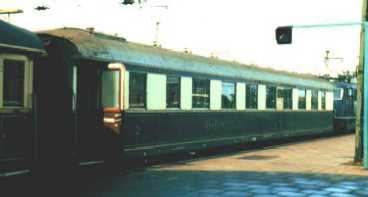 Mönchengladbach Hbf (By Michael Frömmel) |
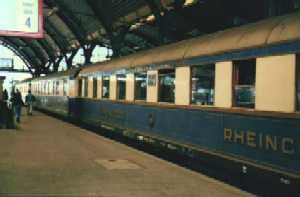 Mönchengladbach Hbf (By Michael Frömmel) |
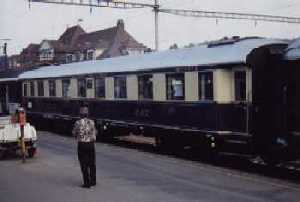 Spiez (By Akira Inoue) September 21, 1991 |
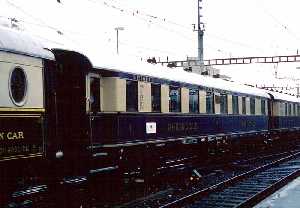 Zürich Hbf (By Nishino) |
For Rheingold new passenger wagons with a length of 23.5m were built.
Some wagons had kitchens. The bogie of the new wagons including baggage
wagons was the type of Görlitz II. The wagons was allowed to run at
the speed of 120km/h. The number of Rheingold wagos was only 29. They were
built by Wegmann, Credee, Westwaggon and Görlitz.
The numbers of 1st class coaches were 20 501 - 20 508, and later 12 501 -508. Each coach of SA4ü28 consisted of three compartments (One was for four people, the others for two people), open plan for 20 people. And each coaches of SA4ük28 consisted of two compartments (One was for four people, the other for two people), an open plan part for 16 people. The seats of the open plan were arranged in 1+1 rows. The numbers of 2nd class coaches 24 517 - 517, 519, and later 10 701 -717, 719. Each 2nd class coach had only an open plan part, and the seats were arranged in 2+1 rows. In 1929, 4 wagons of SA4ük29 (With kitchen), and 2 wagons of SA4ü29 (Without kitchen) were built. In 1934, three wagons of 2nd class without kitchen (10 704/706/710) were rebuilt, and then they had both 1st class and 2nd class. Their name bacame SAB4ük28/34 but their number did`t change. The interior of these wagons cosisted of 24 seats of 2nd class open plan, a 1st class compartment for four people, two 1st class compartments for two people, and a kitchen. One per two Rheingold wagons had kitchen and meal service were served. And three baggage wagons of SPw4ü28 with a weight of 41.2t were built. Their length was 19.68m, and they were similar to other normal baggage wagons. Their number was 90 201 - 203, and after 1931 105 001 - 003. The livery of passenger wagons was blue/beige, and that of baggage wagons was blue. Passenger wagons had the signs `Deutche Reichsbahn Gesellscahft` and `MITROPA`, and the emblem of DRG in the side of them. Later they had the sign `RHEINGOLD`, too. Rheingold Wagons were allocated at Köln-Betriebs-Bhf and were examined at Opladen. |
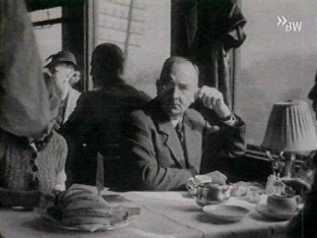 On Board in 1938 (From a TV program by SWR) |
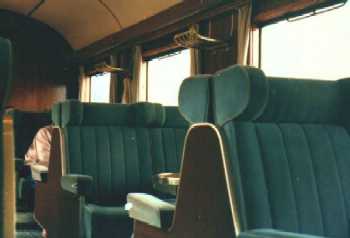 Interior (By Michael Frömmel) |
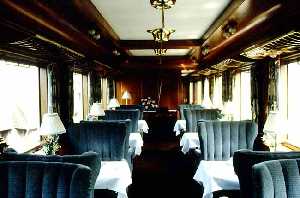 (By Y.Nishino) |
![]()
| Rheingold Wagons List |
| Number | Class | Seats | Producer | Built Year | Numbers after 1931 |
| 20 501 | SA 4üK-28 | 20 | Linke-Hofmann | 1928 | 10 501 |
| 20 502 | SA 4ü-28 | 28 | Linke-Hofmann | 1928 | 10 502 |
| 20 503 | SA 4üK-28 | 20 | Linke-Hofmann | 1928 | 10 503 |
| 20 504 | SA 4ü-28 | 28 | Linke-Hofmann | 1928 | 10 504 |
| 20 505 | SA 4üK-28 | 20 | Wegmann | 1928 | 10 505 |
| 20 506 | SA 4ü-28 | 28 | Wegmann | 1928 | 10 506 |
| 20 507 | SA 4üK-28 | 20 | Westwaggon | 1928 | 10 507 |
| 20 508 | SA 4ü-28 | 28 | Westwaggon | 1928 | 10 508 |
| 24 501 | SB 4üK-28 | 29 | Linke-Hofmann | 1928 | 10 701 |
| 24 502 | SB 4ü-28 | 43 | Linke-Hofmann | 1928 | 10 702 |
| 24 503 | SB 4üK-28 | 29 | Wegmann | 1928 | 10 703 |
| 24 504 | SB 4ü-28 | 43 | Wegmann | 1928 | 10 704 |
| 24 505 | SB 4üK-28 | 29 | Wegmann | 1928 | 10 705 |
| 24 506 | SB 4ü-28 | 43 | Wegmann | 1928 | 10 706 |
| 24 507 | SB 4üK-28 | 29 | Westwaggon | 1928 | 10 707 |
| 24 508 | SB 4ü-28 | 43 | Westwaggon | 1928 | 10 708 |
| 24 509 | SB 4üK-28 | 29 | Westwaggon | 1928 | 10 709 |
| 24 510 | SB 4ü-28 | 43 | Westwaggon | 1928 | 10 710 |
| 24 511 | SB 4üK-28 | 29 | O & K für Credé | 1928 | 10 711 |
| 24 512 | SB 4ü-28 | 43 | O & K für Credé | 1928 | 10 712 |
| 24 513 | SB 4üK-29 | 29 | Linke-Hofmann | 1929 | 10 713 |
| 24 514 | SB 4ü-29 | 43 | O & K für Credé | 1929 | 10 714 |
| 24 515 | SB 4üK-29 | 29 | Linke-Hofmann | 1929 | 10 715 |
| 24 516 | SB 4ü-29 | 43 | O & K für Credé | 1929 | 10 716 |
| 24 517 | SB 4üK-29 | 29 | Wegmann | 1929 | 10 717 |
| 24 519 | SB 4ü-29 | 29 | Wegmann | 1929 | 10 719 |
| 90 201 | SPw4ü-28 | - | Wumag | 1928 | 105 001 |
| 90 202 | SPw4ü-28 | - | Wumag | 1928 | 105 002 |
| 90 203 | SPw4ü-28 | - | Wumag | 1928 | 105 003 |
| Wegmann : Kassel, Linke Hofmann : Breslau, Westwaggon : Köln-Deutz, O&K für Credé : Kassel, Wumag : Görlitz |
| Data from "RHEINGOLD" (alba) |
![]()
| Locomotive |
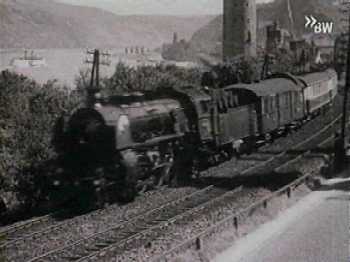 (From a TV program by SWR) |
| Before WWII, each "Rheingold" train was operated by three
locomotives. At first, Rheingold was operated only by a steam locos with
4 cylinders. Between Hoek von Holland and Zevenaar and between Amsterdam CS and Utrecht, the train was hauled by class 3700, later by class 3900. Between Zevenaar and Mannheim it was hauled by BW Wiesbaden`s class 18.4 (Former Bayern S3/6), and in the south of Mannheim by BW Offenburg`s class 18.3 (Former Baden IVh). In Switzerland class Ae4/7 hauled "Rheingold". Class 01 had already entered in service, but it was not used for "Rheingold". It was because the weight per one axle was too heavy for Linke Rheinstrecke. At that time the weight per an axle was limited to 18t, but that of class 01 was 19.8t. When the train was delayed, the locos were not exchanged. And sometimes class 38.10-40 hauiled this train instead of class 18.3. At first five locomotives of class 18.4 (18.441 / 445 / 447 / 450 / 451) were used for "Rheingold" but later other locomotives of class 18.4 and locomotives of class 18.4-5 (18 479 -548) were also used. From 1931, "Rheingold" was hauled between Zevenaar and Mannheim by BW Mainz`s locomotives, and 18 521 - 528 were moved from BW Wiesbaden to BW Mainz. In April and May 1931, Rheingold locos between Mannheim and Basel were exchanged from class 18.3 to class 01 077 - 081. And From 1934 class 01 hauled "Rheingold" between Zevenaar and Mannheim, too. Then class 01 hauled Rheingold in Germany until 1939. Class 01 hauled Rheingold for longer time than any other locos did. But many railway fans still prefer class 18.4. |
![]()
| Train Composition |
| Usually Rheingold was composed by two 1st class wagons, two 12nd class
wagons, and one baggage wagon. And one wagons per two had kitchen. Sometimes
one 1st class wagon, one 2nd class wagon, and one baggage wagon were also
coupled. Since the number of SPw4ü28 was only 3 (2 wagons were used,
and the other was a spare wagon.), sometimes normal baggage wagon with
green livery was coupled to Rheingold. Rheingold wagons weighed about 10t heavier that those of other trains, it was impossible to couple more than 9 wagons to run fast. Those are some exapmples of the composition. |
| SPw4ü28 Hoek van Holland - Zurich |
SA4ük28 Hoek van Holland - Zurich |
SA4ü28 Hoek van Holland - Zurich |
SB4ük28 Hoek van Holland - Zurich |
SB4ü28 Hoek van Holland - Zurich |
SB4ük28 AmsterdamCS - Luzern |
SA4ü28 AmsterdamCS - Luzern |
Pw4ü AmsterdamCS - Luzern |
| SPw4ü28 Hoek van Holland - Chur |
SA4ük28 Hoek van Holland - Chur |
SAB4ük28 Hoek van Holland - Chur |
SB4ü28 Hoek van Holland - Chur |
SB4ü28 AmsterdamCS - Luzern |
SA4ük28 AmsterdamCS - Luzern |
Pw4ü AmsterdamCS - Luzern |
| SPw4ü28 Hoek van Holland - Basel SBB |
SA4ük28 Hoek van Holland - Basel SBB |
SA4ü28 Hoek van Holland - Basel SBB |
SB4ük28 Hoek van Holland - Basel SBB |
SB4ü28 Hoek van Holland - Basel SBB |
| SPw4ü28 Hoek van Holland - Basel SBB |
SA4ük28 Hoek van Holland - Basel SBB |
SAB4ük28 Hoek van Holland - Basel SBB |
SB4ü28 Hoek van Holland - Basel SBB |
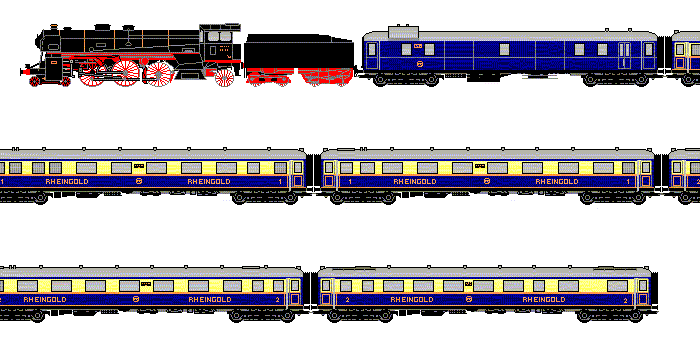 |
![]()
| Rival |
| To compete with "Rheingold", CIWL made a new trains between
England and Switzerland a month after the strat of "Rheingold".
The train "Edelweiss" was operated between Amsterdam and Zurich
by Brussel, Luxembourg and Baden. In summer some of the wagons of this
train went to Luzern by Olten. From 1929 summer to 1932, "Edelwess" and "Rheingold" was couple each other in Switzerland, but later they were operated as different trains. "Edelweiss" was also abolished before the start of WWII. |
![]()
| Special Operation |
| Some wagons of pre-war Rheingold have been preserved and used for special trains. |
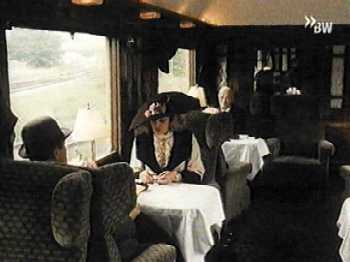 50 Year Anniversary of Rheingold in 1978 (From a TV program by SWR) |
|
![]()
| Intraflug Zürich bought some pre-war Rheingold wagons, and rebuilt a part of them. One wagon was rebuilt to Bar car. (The picture below shows it.) |
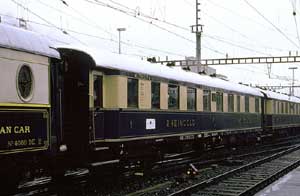 Zürich Hbf (By Y.Nishino) |
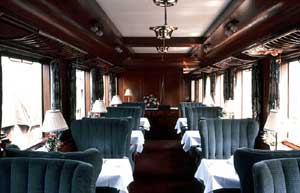 (By Y.Nishino) |
![]()
| Back |